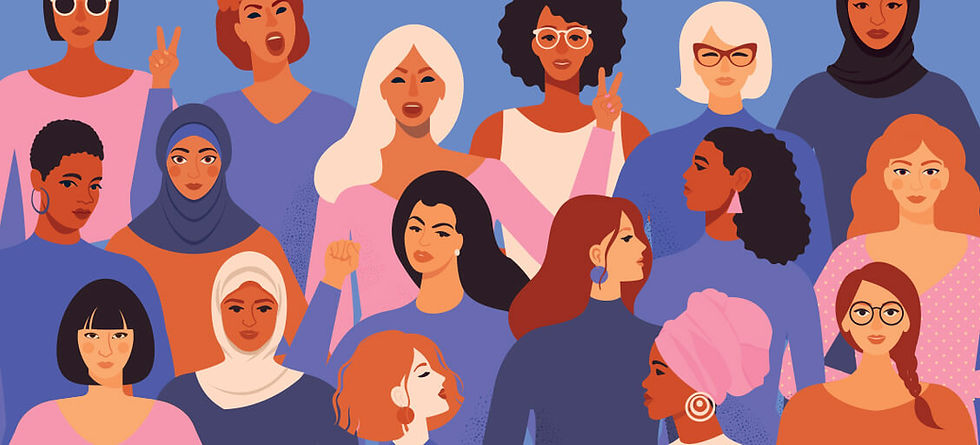Women and the Pandemic
- Saniya Vashist

- Jun 20, 2021
- 4 min read
By Mona Chahfe
In recent months, we have started to believe we’re leaving the worst behind during this pandemic. Be it with the ability to get the vaccine, finally getting to see faraway family, or planning an international trip, we are all searching for the light at the end of the tunnel.
As important as it is to envision a future where the pandemic is behind us, half of our population will continue to face long lasting impacts. That half is comprised of women around the world. When looking at the effects COVID-19 has had on women, we see that even as the world finds itself getting better, the losses women have faced would leave them with detrimental setbacks, even as circumstances improve for others.

Women’s careers take a hit
Before the onset of COVID-19, the representation of women in corporate America was improving. Not only was there an increase in women holding leadership positions in corporate companies, but the number of women of color who were being represented and promoted was also increasing. This progression quickly halted, and the pandemic instantly affected women in the workforce. In a study conducted by McKinsey & Company, it was found that one in four women are considering leaving the workforce or downshifting their careers versus one in five men. The groups of women that have been most impacted by COVID-19 according to McKinsey & Company are working mothers, women in senior management positions, and black women. Even as women face a growing employment crisis, they are still feeling burned out and under more pressure than men in the workforce.
If some form of action is taken now to improve gender equity, McKinsey Global reports that such effects could add $13 trillion to global GDP by 2030. Though reforms are difficult as the economy re-emerges from the pandemic, opportunities to have women enter high-paying positions in the workforce are plentiful. By investing in education, family planning, and women’s health care, the world can not only re-evolve but strengthen from the negative effects on women’s employment from the pandemic. But, for such an effort to be true, there is a great deal of change that needs to take place, or else, as McKinsey & Company warns, things will only get worse for all of us.

The importance of women’s education
Similar to employment, before COVID-19, the educational divide for women had been declining. There had been so much progress that places had seen a ‘reverse’ gap in which girls not only had a higher enrollment rate but higher test scores than boys. However, COVID-19 has threatened this growth by putting education on hold for many women. Due to the economic and personal struggles caused by the pandemic, education has become less of a priority to women once again. Studies have found within developing countries, the pandemic has increased the risk of women dropping out of school, becoming vulnerable to domestic violence, child marriages, early pregnancies, and the exploitative child labor. UNESCO has projected that these challenges brought by the pandemic will prevent approximately 11 million girls from returning to school this year. This concerning prediction must be addressed immediately. Not only does this cultivate a future in which fewer women receive proper education but it also affects women continuing to gain leadership roles in the workplace.

What do we do now?
The entire world has been affected by the pandemic, but it is important to look at how women in particular have faced crippling setbacks during these times. From the workplace, to the very grounding of their education, women’s voices are being challenged. As the pandemic is threatening a woman’s chance to learn and step up in her career, her voice in the society goes unheard. Thus, not only is it essential that we take the time to learn about the difficulties women are facing, but to actually make sure steps are being made to initiate change. As the research reveals, as the pandemic gets better and the world gets back to normal, if no efforts are made to help women re-enter schools and workforce, many will remain left behind. So, what can we do?
Here are some suggestions:
Continue to create awareness for this issue. By keeping up with this topic, remaining knowledgeable about the pandemic's effects on women is important to keep the notion that change needs to occur alive.
Hire managers and recruiters that are advocating gender equality. Our leaders, whether male or female, need to be considerate towards women and aware of these struggles that the pandemic has heightened in their education and work lives.
Be more empathetic towards women. Listening to their stories and their struggles and to be understanding about the challenges each individual woman has endured from this pandemic. We must create an environment that empowers women and even more so gives them a place where they can re-strengthen and push through such setbacks
Support women-led organizations, like codeHER!
As always, we rely on your support to continue our programs, and empower women from every part of the world. Support codeHER today- it only takes a minute. Thank you!

Sources:
“COVID-19 Has Harmed Girls' Education. Here's What Needs to Be Done.” World Economic Forum. www.weforum.org/agenda/2021/04/covid-19-has-harmed-girls-education-here-s-what-needs-to-be-done/.
“Seven Charts That Show COVID-19's Impact on Women's Employment.” McKinsey & Company. www.mckinsey.com/featured-insights/diversity-and-inclusion/seven-charts-that-show-covid-19s-impact-on-womens-employment



Comments